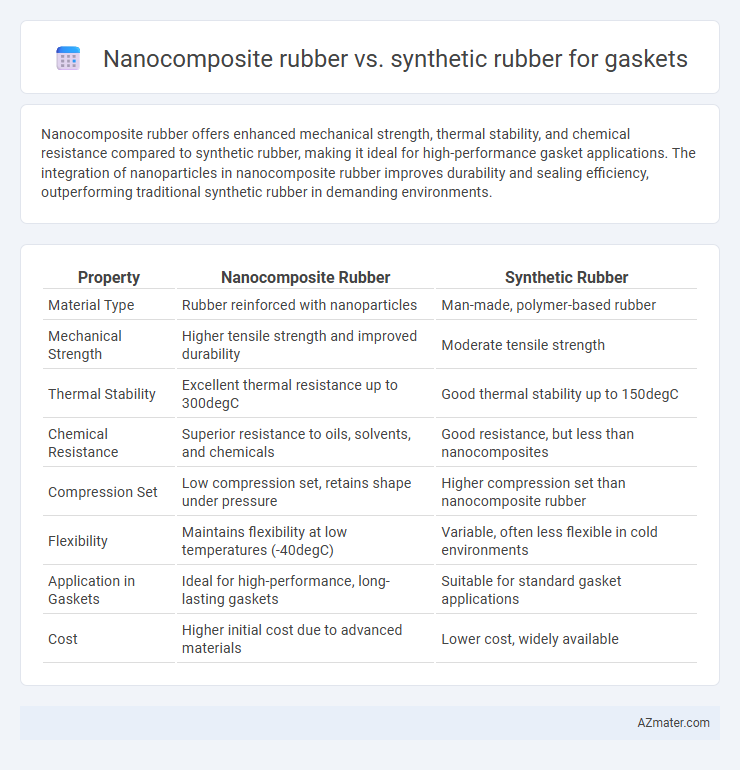Nanocomposite rubber offers enhanced mechanical strength, thermal stability, and chemical resistance compared to synthetic rubber, making it ideal for high-performance gasket applications. The integration of nanoparticles in nanocomposite rubber improves durability and sealing efficiency, outperforming traditional synthetic rubber in demanding environments.
Table of Comparison
| Property | Nanocomposite Rubber | Synthetic Rubber |
|---|---|---|
| Material Type | Rubber reinforced with nanoparticles | Man-made, polymer-based rubber |
| Mechanical Strength | Higher tensile strength and improved durability | Moderate tensile strength |
| Thermal Stability | Excellent thermal resistance up to 300degC | Good thermal stability up to 150degC |
| Chemical Resistance | Superior resistance to oils, solvents, and chemicals | Good resistance, but less than nanocomposites |
| Compression Set | Low compression set, retains shape under pressure | Higher compression set than nanocomposite rubber |
| Flexibility | Maintains flexibility at low temperatures (-40degC) | Variable, often less flexible in cold environments |
| Application in Gaskets | Ideal for high-performance, long-lasting gaskets | Suitable for standard gasket applications |
| Cost | Higher initial cost due to advanced materials | Lower cost, widely available |
Introduction to Gasket Materials
Nanocomposite rubber enhances gasket performance by integrating nanoparticles into traditional rubber matrices, resulting in superior mechanical strength, thermal stability, and chemical resistance compared to synthetic rubber alone. Synthetic rubber, commonly used in gasket manufacturing due to its elasticity and durability, lacks the advanced reinforcement properties provided by nanocomposites. The incorporation of nanomaterials in gasket formulations optimizes sealing efficiency and longevity under extreme operational conditions.
What is Nanocomposite Rubber?
Nanocomposite rubber is an advanced material composed of a rubber matrix embedded with nanometer-sized fillers, which significantly enhance its mechanical strength, thermal stability, and chemical resistance compared to traditional synthetic rubber. These nanoscale reinforcements improve the gasket's durability, sealing performance, and resistance to wear under extreme conditions. This makes nanocomposite rubber an ideal choice for high-performance gaskets in automotive, aerospace, and industrial applications demanding superior reliability and longevity.
Defining Synthetic Rubber
Synthetic rubber is a man-made elastomer produced through polymerization of specific monomers like butadiene and styrene, designed to mimic natural rubber's properties with enhanced chemical resistance and temperature stability. Nanocomposite rubber incorporates nanoscale fillers such as silica or carbon nanotubes into synthetic rubber matrices, significantly improving mechanical strength, thermal stability, and sealing performance for gasket applications. Compared to traditional synthetic rubber gaskets, nanocomposite variants offer superior durability, reduced permeability, and enhanced resistance to wear and environmental degradation.
Key Differences Between Nanocomposite and Synthetic Rubber
Nanocomposite rubber for gaskets incorporates nanoscale fillers such as clay, carbon nanotubes, or silica, enhancing mechanical strength, thermal stability, and chemical resistance compared to traditional synthetic rubber. Synthetic rubber gaskets, typically made from materials like Nitrile (NBR), EPDM, or Neoprene, offer good general-purpose elasticity and oil resistance but lack the superior performance characteristics imparted by nanofillers. The key differences lie in durability, with nanocomposite rubber providing improved wear resistance and lifespan in harsh environments, making it suitable for high-performance sealing applications.
Mechanical Properties Comparison
Nanocomposite rubber exhibits superior mechanical properties compared to synthetic rubber for gasket applications, including enhanced tensile strength, improved abrasion resistance, and greater elasticity. The incorporation of nanoscale fillers into the rubber matrix significantly increases stiffness and durability without compromising flexibility. These improvements result in longer-lasting gaskets that maintain sealing integrity under high stress and varying temperatures.
Chemical Resistance and Durability
Nanocomposite rubber gaskets exhibit superior chemical resistance due to the embedded nanoparticles that enhance barrier properties against oils, solvents, and aggressive chemicals, outperforming traditional synthetic rubber variants like NBR or EPDM. Their enhanced durability results from improved mechanical strength and resistance to abrasion, heat, and aging, ensuring longer service life in harsh environments. Synthetic rubber gaskets generally offer good chemical resistance and flexibility but may degrade faster under prolonged exposure to extreme chemicals and temperatures compared to nanocomposite alternatives.
Temperature Tolerance and Stability
Nanocomposite rubber gaskets demonstrate superior temperature tolerance, maintaining structural integrity and flexibility at temperatures ranging from -50degC to 250degC due to the enhanced thermal properties of embedded nanofillers. In contrast, synthetic rubber gaskets such as nitrile, EPDM, or neoprene typically withstand a narrower temperature range between -40degC and 150degC, with performance degradation occurring at higher thermal stress. The improved temperature stability of nanocomposite rubber ensures longer gasket life and reliability in extreme thermal environments compared to conventional synthetic rubber materials.
Cost Considerations and Availability
Nanocomposite rubber gaskets generally exhibit higher initial costs due to advanced filler materials like graphene or nanoclays, which enhance mechanical properties and chemical resistance. Synthetic rubber gaskets, such as those made from nitrile or EPDM, offer more cost-effective and widely available options for standard sealing applications. Availability of synthetic rubber is higher, supported by established manufacturing processes and supply chains, while nanocomposite variants may face limited sourcing and longer lead times.
Application Suitability for Gasket Production
Nanocomposite rubber offers enhanced mechanical strength, thermal stability, and chemical resistance, making it highly suitable for gasket applications exposed to extreme temperatures and aggressive chemicals. Synthetic rubber provides good elasticity and resilience, ideal for standard gasket production in automotive and industrial sealing where moderate temperature and chemical exposure occur. Nanocomposite rubbers improve gasket durability and lifespan in demanding environments, outperforming conventional synthetic rubber in high-performance sealing applications.
Future Trends in Gasket Material Innovation
Nanocomposite rubber offers enhanced mechanical strength, superior thermal stability, and improved chemical resistance compared to synthetic rubber, driving its growing adoption in gasket applications. Innovations in nanomaterial integration, such as graphene and silica nanoparticles, are paving the way for gaskets with longer service life and greater reliability under extreme conditions. Future trends indicate a shift towards eco-friendly, high-performance nanocomposite rubber formulations that meet stringent environmental regulations and industry standards.

Infographic: Nanocomposite rubber vs Synthetic rubber for Gasket
 azmater.com
azmater.com